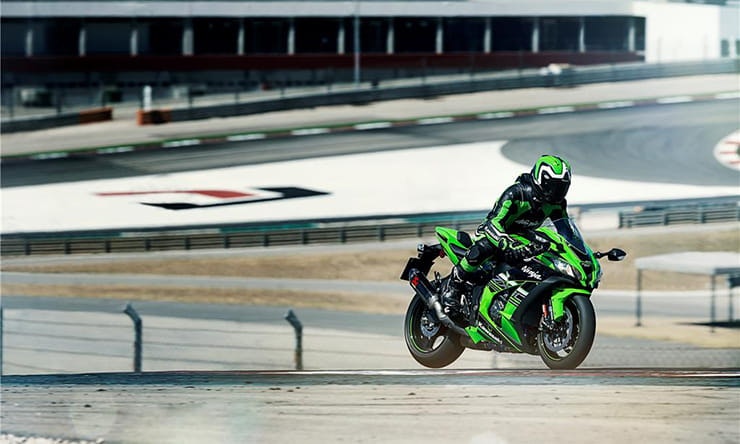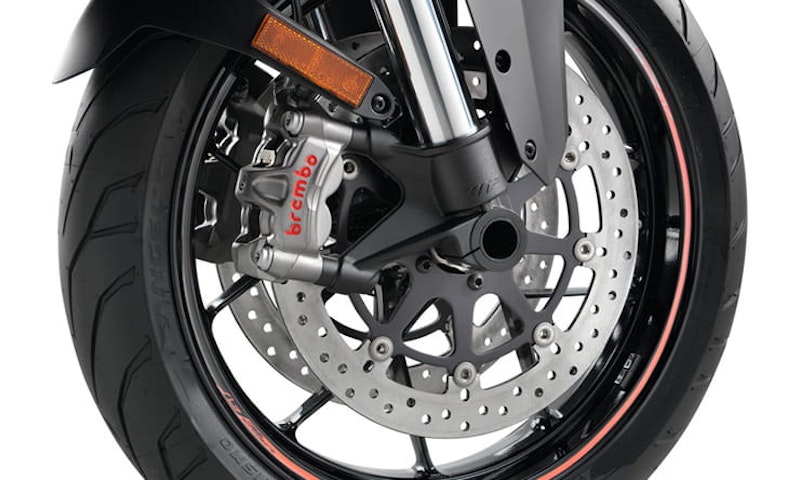How can one finger exert this much stopping power? By the cunning force multiplication that takes place in your braking system…
If you’ve ever experienced brake fade or, god forbid, brake failure, you’ll have an appreciation of just how important it is that brakes work consistently. Here are the basic principles and components for modern brakes – and by that we mean hydraulic ones, with discs not drums.
It’s all about hydraulics
Modern motorcycle brakes work by transferring movement and force at the lever through an incompressible liquid to the caliper pistons, which then press the brake pads against the disc. For that force to be transferred efficiently, the brake lines must not expand, there must be no leaks and the fluid must not compress. If any of those happen, you get spongey-feeling brakes, or indeed no brakes. Gulp.
There are pistons at each end
The brake lever operates a piston, which operates as a plunger in what’s called the master cylinder. Both are housed in the casting that holds the brake lever. A master cylinder piston is pretty small - around 10-20mm in diameter. The pistons at the other end, in the calipers, are much bigger – around 25-50mm. Why the different sizes? That leads us to…
Forces are amplified
The first way that forces are amplified are at the lever itself. This is purely mechanical – if your fingers are 10cm from the pivot point, and the master cylinder piston is 2cm the other side, then forces will be magnified 5 times, but there will be five times less movement. Then there’s amplification due to piston sizes. The smaller the master cylinder piston, the more pressure it will apply to the system for a given force at the lever. If that sounds counter-intuitive, imagine your foot being trodden on by someone wearing a stiletto heel. It’ll be a lot more painful than if they’re wearing a broad shoe. The pressure in the system is then transferred to the caliper pistons, and the force they generate depends on the ratio of the areas of the piston faces. So let’s say the master cylinder piston has a diameter of 15mm, meaning its area is 177mm squared. Our caliper piston has a diameter of 25mm, giving a surface area of 1964mm squared. So the force is multiplied 11 times. Combine that with the lever, and in this case you’re magnifying the force 55 times. And that’s just with one caliper piston. On a modern front end there are usually four pistons in each caliper, and there are two of those. That gives a 440 times force multiplication in our example. No wonder you can use two fingers to make the bike stand on its nose.
Changing piston sizes changes everything
A smaller master cylinder piston will apply more pressure and create more braking force but it will move less fluid, so the lever will have to move further to move the caliper pistons enough make the pads grip the discs. That means there is a limit to how small you can go with master cylinder pistons, and how big the caliper pistons can be. Also, big caliper pistons mean you need big discs (check out a cruiser rear brake), which are heavy.
Different size caliper pistons are a good idea
Many modern four-piston calipers have two smaller pistons. This is to increase feel. The smaller pistons will move further than the larger ones and therefore push the brake pad before the others join in.
Radial brakes have the caliper bolts directed at the wheel spindle
Caliper design has changed
There have been two main caliper innovations in the last couple of decades. Radial calipers (named because they are attached by bolts which radiate from the wheel centre, rather than laterally from a mounting bracket) are stiffer and perform better under extreme conditions, such as racing. For 99% of us, they make no difference. Monoblock calipers, as the name suggest, are made from one lump of metal, rather than two bolted together. This eradicates the tiny amount of flex between the two halves of a normal caliper and in theory gives better feel. Again, most of us can’t ride hard enough to notice the difference.
Friction is what stops you
Once you’ve got forces arriving at the caliper pistons, it’s then over to the brake pads. These have to convert the kinetic energy of you and the bike into heat by rubbing against the discs. This is some task – if you’re shifting, there’s a hell of a lot of energy, which means a lot of heat.
Non-radial brakes are attached to a bracket. Unless you’re racing, they’re just as good as radials
Brake pads: the choice
For most modern bikes, you’ll want HH pads, which have the highest coefficient of friction – both at normal temperatures (the first H) and at 350C (the second). Then it’s a case of choosing the material, and how it’s made. Organic pads are nothing of the sort – it just means there is no metal in them. They are cheap, gentle on discs, don’t last as long and fade if you hammer them. Not the best choice for sportsbikes. Semi-metallic pads contain some metal, and have a higher friction coefficient than organics and better fade characteristics. Then there are sintered pads. These have a high coefficient of friction and good heat transfer. They’re more expensive and can be hard on discs, but are the ones to have if you’ve got a powerful bike.
Finally, the fluid
Brake fluid is easily forgotten, as it just sits there transfering brake forces from lever to pads. The problem is that brake fluid can degrade, potentially allowing your brakes to fade under hard use. For motorcycles there are three types: DOT 3, 4 and 5.1 (forget DOT 5 – it’s not recommended for bikes). The numbers refer to boiling points and viscosity. Generally, the higher the DOT number, the better the fluid – it will be lower viscosity and have a higher boiling point (this is important because you don’t want the fluid boiling, and becoming compressible, when your brake pads get hot). The problem with all these fluids is they absorb water from air, which lowers their boiling point. That’s why you should change your brake fluid every two years and make sure any brake fluid bottles are tightly sealed.

